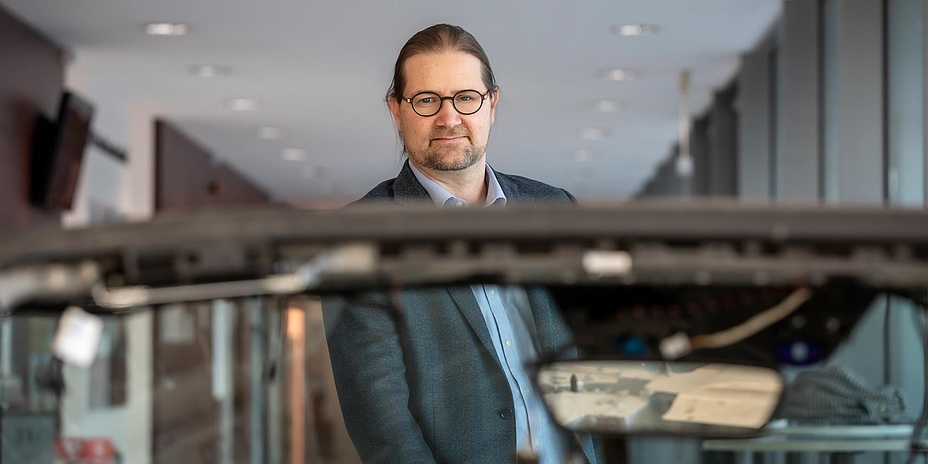Digital Transformation in Mobility: "The Potential Is There, But It Won't Fall into Our Laps."

Mario Hirz, deputy head of the Institute of Automotive Engineering at Graz University of Technology (TU Graz), is aware of the opportunities and challenges digitalization holds in store for the mobility sector. In an interview for Face-to-face, he explains how we will move around in the future and what opportunities are opening up for passenger and freight transport.
In my estimation, the technology will come to us from overseas in five years.
The title of your keynote speech is "Digitalization of passenger and freight transport: how will we move around in the future?" Without wanting to pre-empt your lecture, what is your answer?
I would like to answer this question on the basis of the mega trend of individualization, which can also be observed in transport: Individual mobility (note: the need to move around flexibly without constraints on time or place) has grown strongly in recent decades. This has led, for example, to car traffic bringing our cities to the brink of collapse because of the space it takes up, the exhaust fumes and the noise. However, it is in this area that the greatest leaps in technology are imminent. One is in the form of new, more environmentally friendly propulsion systems. The other is about automation. Autonomous driving opens up completely new possibilities; robot cars will fundamentally change our mobility behaviour.
Can you clarify that with an example?
Intelligent on-demand services will make owning a car obsolete. In the future, for example, we will use an app to order an environmentally friendly robot taxi that will pick us up in a few minutes, take us comfortably to our destination and, if necessary, pick up other passengers along the way. Even for the pizza or supermarket shopping, we no longer need to get behind the wheel ourselves. Autonomous 24-hour delivery services deliver goods to us whenever and wherever we want.
But bicycle courier services can already manage that today.
In the city centre these bicycle services are effective, and autonomous cars will not displace them there. In rural areas, however, delivery is not yet possible across the board. And even the urban fringes are often outside the delivery radius of bicycle couriers. Self-driving cars have completely different ranges here and can also deliver much larger and heavier goods.
When will such services become a reality here?
In America, test fleets of autonomous delivery vehicles are already operating today, for example on California's roads. The robot taxis of the Google subsidiary Waymo covered 630,000 miles on public roads in 2020 – with just 144 vehicles, please note. During this time only(!) 21 errors have been documented. In other words, cases where remote or manual intervention by safety personnel was required to prevent an accident. The General Motors offshoot for self-driving cars GM Cruise presented similar figures. And the Amazon company Zoox presented the first prototype of its robo-taxi at the turn of the year. In other words:
Autonomous driving is much closer than some think!
As demonstrated by the companies mentioned above as well as some Asian companies at the forefront of development. I expect to see widespread use of autonomous cars in the U.S. in one to two years.
And when will we see robot cars on Europe's public roads?
A few years ago, it was assumed that autonomous driving would not be possible until 2040. Although these figures have long been outdated, it will take a little longer in Europe. In my estimation, the technology will come to us from overseas in five years.
How can this "time-lag" be explained?
There are two reasons for this: on the one hand, tech giants such as Google, Apple, Amazon and even Tesla invested in these technologies early on. On the other hand, the legal framework in Europe has made it difficult to develop and test autonomous vehicles. For example, the Vienna Road Traffic Convention of 1968 states that "the driver must always be in full control of his or her vehicle". This passage was softened somewhat in 2016 in favour of automation. Since then, autonomous vehicles have been permitted on the condition that they can be switched off by humans at any time. In the meantime, we also have a number of test regions for automated driving, including, for example, the ALP.Lab, test region, in which TU Graz is also participating.
Is Europe falling behind in technological change?
In Europe, we are acting more cautiously, especially with regard to technologies that pose a potential risk to health or goods safety. But it is also a fact that Europe is a nucleus for cutting-edge research and cutting-edge technologies, especially in the mobility sector. The decisive competitive factor will be that we bring this expertise in new technologies to the companies.
How can this succeed?
With investment in digital skills. This is precisely where the new university course Leadership In Digital Transformation comes in.
In what way?
Companies that want to remain fit for the future must train their employees, starting with their managers. The course is aimed at this target group. Participants are given the tools to recognize development trends at an early stage. With the help of the training, they know what know-how and resources are needed to successfully implement digital transformation. Finally, as managers they must ensure that all employees involved receive appropriate training. This is an elaborate process, as our institute was able to experience in a real-life application.
Can you give an example here?
A German company that supplies components for vehicles with internal combustion engines contacted us in 2018. With regard to the future strategic direction of the company, we were asked how the trend towards fewer combustion engines would develop. Our analyses had shown that there will be less growth in this market segment in the future. So, with our support, the product portfolio was expanded and new business models were developed. In addition, a training programme lasting several weeks was developed for employees to build up expertise in electrical engineering, electronics and digitalization. Today, the company develops and produces systems for autonomous vehicles, among other things, and continues to expand.
So, new mobility concepts create jobs...
Yes, however, these require a certain digital aplomb and resilience. If we don't invest in the education and training of these skills, the jobs will go to other countries. “In short, the potential is there, but it won't fall into our laps."
Kontakt
The university course Leadership in Digital Transformation planned for autumn imparts competencies for digital transformation in a wide range of industries. The course starts in autumn Applications are open until June 30, 2021. Further details (costs, course structure, duration): www.LeadTransformation.tugraz.at

![[Translate to Englisch:]](https://www.tugraz.at/fileadmin/_processed_/9/8/csm_banner-thek-by-privat_a42f57f7b3.jpg)


